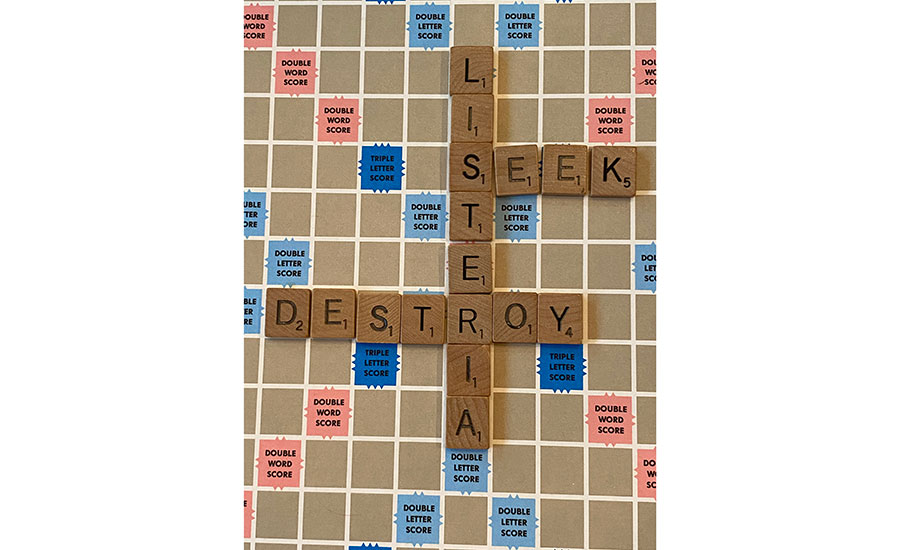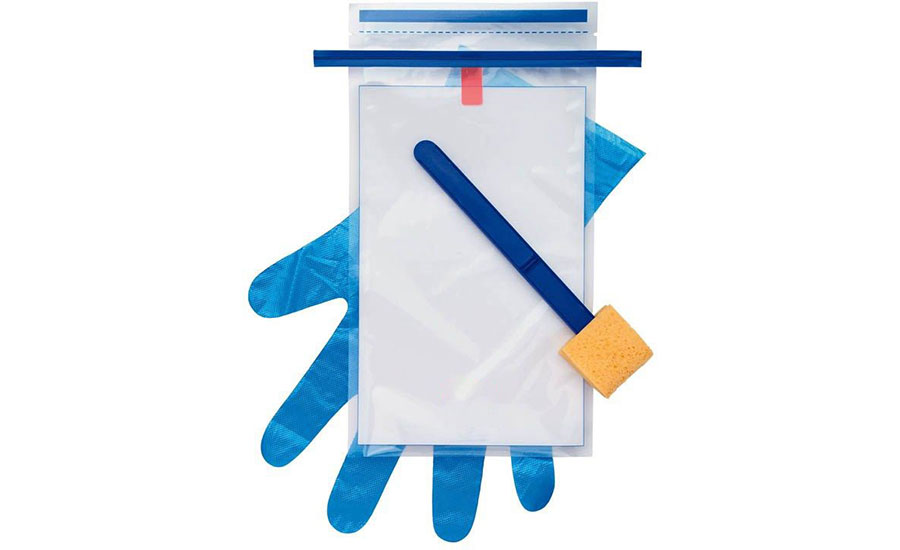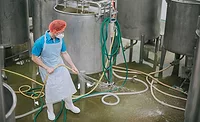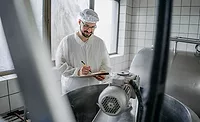Keeping Listeria on the Run: Implementing an Effective Monitoring Program
A good Listeria monitoring program enables knowledge of where Listeria can enter, harbor, and move through the facility

Image credit: wildpixel/iStock / Getty Images Plus via Getty Images
Every time I teach virtual classes or give a presentation, I like to begin with what I believe are the obligations of food manufacturers. It is important to provide the "why," or the motivation for the programs we implement that relate to food safety, quality, and regulatory conformance. Included in these obligations are:
- Consumer/customer protection—Ensuring that consumers are not harmed by consuming our products and that customers are not inconvenienced by complaints, recall, or removal of product from their shelves
- Company/brands—Ensuring that the company reputation is not harmed, that there are no negative financial consequences, and that the brands we have worked so hard to market are not associated with foodborne illness or injury
- Regulatory requirements—We all operate in a regulatory environment, so we want to make sure that we conform to regulatory requirements to avoid regulatory control action or additional scrutiny for the operations of our products.
Implementing an effective Listeria monocytogenes environmental monitoring program (EMP) is an important way to ensure that a company will meet obligations to consumer/customer protection, maintain its reputation and its brands, and conform to regulatory requirements. A good Listeria monitoring program enables knowledge of where Listeria can enter, harbor, and move through the facility, which is the first step toward keeping it on the run and not allowing it to impact production surfaces or finished product. Many of us who had the great fortune to learn from Bruce Tompkin, Ph.D., have heard him explain that Listeria will continue to be introduced to the food environment, so it is incumbent for us to continue to identify where we can find it in the plant. This process is often referred to as "Seek and Destroy"—a method pioneered by John Butts, Ph.D.—with the "seek" portion being the monitoring program. The goal is to find Listeria in the environment and then implement the "destroy" component and eliminate it when it is found, as well as prevent recurrence (Figure 1).

It is important to understand the regulatory requirements before setting up your program, as they may help guide you toward an effective plan. A good starting point is a review of 9 CFR 430.4, "Control of Listeria monocytogenes in post-lethality exposed ready-to-eat products." This rule provides meat and poultry facilities with the basic requirements for implementing a Listeria monitoring program, starting with a definition of ready-to-eat (RTE) products. The U.S. Department of Agriculture (USDA) defines RTE products as "A meat or poultry product that is in a form that is edible without additional preparation to achieve food safety." What this means is that the consumer does not need to cook the product to kill bacteria; the food can be warmed for palatability or can be eaten directly from the package without heating. Since RTE products are exposed to the manufacturing environment post-lethality, it is vital to have a HACCP plan to control the lethality process, a Sanitation Standard Operating Procedure (SSOP) to ensure cleaning and disinfection of direct contact surfaces, and a Listeria EMP to ensure that these programs are effective and to identify sites where Listeria could harbor and translocate.
Now that you know what is required, how do you begin?
Identify the Alternative
One of the first steps may be to identify the alternative that your product falls into, as defined in 9 CFR 430. This may help lead to the determination of the sampling and frequency needed to conform to the rule, as well as to ensure that your RTE product is protected. USDA has identified three alternatives:
- Alternative 1: A product that uses a post-lethality treatment, such as an antimicrobial agent that reduces or eliminates microorganisms on the product and an antimicrobial agent or process that suppresses or limits the growth of Listeria. If this alternative is selected, then the antimicrobial agent or process must be included in the facility HACCP plan or the SSOP and must validate the effectiveness of the post-lethality treatment.
- Alternative 2: A product that uses a post-lethality treatment, such as an antimicrobial agent that reduces or eliminates microorganisms on the product or an antimicrobial agent or process that suppresses or limits the growth of Listeria. If this alternative is selected, then the antimicrobial agent or process must be included in the facility HACCP plan or the SSOP and must validate the effectiveness of the post-lethality treatment.
- If this alternative is selected, then the plant must also establish testing of post-lethality of direct product contact surfaces, state the frequency with which the testing will be carried out, the locations to be tested, and why the testing frequency is sufficient to ensure control of Listeria.
- If this alternative is selected, it is likely that the establishment will be subject to more frequent verification testing by USDA's Food Safety and Inspection Service (FSIS) or the U.S. Food and Drug Administration (FDA) than Alternative 1.
- Alternative 3: The establishment uses only sanitation measures to prevent Listeria.
- If this alternative is selected, then the plant must also provide for testing of post-lethality of direct product contact surfaces, state the frequency with which the testing will be carried out, the locations to be tested, and why the testing frequency is sufficient to ensure control of Listeria.
- If the establishment produces deli meat or hot dogs, then it must also ensure that the corrective actions for a positive Listeria or indicator organism (i.e., Listeria spp.) are effective.
- During the follow-up testing for a positive result, the establishment will hold product until the corrective actions for the initial positive are completed, and the lot will be sampled/tested for Listeria or indicator organisms using a sampling plan that will provide a high level of statistical confidence that the lot is not adulterated.
- If this alternative is selected, it is likely that the establishment will be subject to more frequent verification testing by FSIS or FDA than Alternative 1.
- Results will be made available to FSIS personnel upon request for review.
Swab Locations
The next step is to develop a list of swab locations in the post-lethality areas of the facility that have the potential to harbor or translocate Listeria. The general expectation is that the sites will be where product is exposed, after the lethality step, and up to/including the primary packaging step.
Note that it is also required to include the primary packaging that will be in direct contact with the RTE product for periodic swab sampling. Although it may seem unlikely that packaging would be a source of contamination, if it is a contact surface, then there must be documentation that it will not adulterate RTE product.
Swab locations must include the following:
- Direct Contact Sites (Zone 1): Sites that RTE ingredients or product come into direct contact with prior to packaging. These may include, at a minimum: blenders, gondolas, fill hoppers, conveyor belts, tables, slicers/dicers, chillers, spiral freezers, and utensils.
- Indirect Contact Sites (Zone 2): Sites that RTE ingredients or product do not come into direct contact with, but are close to Direct Contact Sites and may become contributors to contamination on Direct Contact Sites. These may be locations that can harbor environmental organisms that can then result in translocation to contact surfaces through movement or handling. These sites may include conveyor frames, the undersides of tables, product racks, and windows around the entrances to chillers and freezers.
- Non-Contact Sites (Zone 3): Sites that are not near the Direct or Indirect Contact Sites, but can be sources of harborage or translocation of environmental Listeria. These sites primarily include floors, drains, and material handling equipment (MHE) features such as wheels and pallets. Again, these sites are far away from the product or product surfaces, but they can result in the spread of organisms through the plant, particularly if they are damaged or not able to be cleaned effectively.
Food manufacturers may also include auxiliary areas (Zone 4) such as offices, restrooms, maintenance shops, warehouses, locker areas, etc. However, before including them in routine swabbing, it is a good idea to ask the question, "What will I do if I get positive results in these areas?" Since these areas are generally high traffic, they may not receive a full cleaning and disinfection. Also, there may be a "decontamination" process after personnel leave Zone 4 and before they enter RTE areas, so they may not be ideal for routine swabbing. Zone 4 areas could be considered as part of the investigation process for a positive routine swab to determine their possible contribution.
An industry best practice is to list the site swabbing locations in a database or to use a simple Excel spreadsheet to log the sites and then randomize the site locations for collection. All identified sites will be sampled at least once a year, and the locations will be reassessed each year to determine if sites may be deleted or if more should be added.
Looking for quick answers on food safety topics?
Try Ask FSM, our new smart AI search tool.
Ask FSM →
Swab Collection
As indicated by the rule, you will determine the frequency with which you will collect swabs (weekly, monthly, quarterly). It is recommended that you randomize the day of the week so that swabs are not always collected on the same day. Collect swabs after 3–4 hours of start of production. This provides an opportunity for equipment to run, for personnel and MHE movement, and for presence of product or ingredients, as these factors can impact the presence of environmental Listeria. Personnel collecting the swabs will be trained to use aseptic sampling technique so that they do not contribute to incidental sample contamination. This includes washing and sanitizing hands, using sanitized gloves, and collecting direct contact sites before indirect and non-contact sites. For best results, use pre-hydrated sponges to ensure that sufficient pressure can be applied, or sponge sticks to get into smaller spaces or to use with swab poles for overhead surfaces such as air handling units, conduits, or piping (Figure 2).
When collecting samples, swab as large of an area as possible; do not be confined to a 4-in.-by-4-in. (10-cm-by-10-cm) swab area. The sample analysis will be qualitative, showing presence or absence of the organism, rather than quantitative, to get the number of organisms per area. You just want to know whether the organism is there. Be sure that the swab bags clearly indicate the date collected and the swab ID. Keep samples refrigerated (but not frozen) until they are processed.
A best practice for the personnel who collect swabs is to keep a list of the locations they will collect. However, it is a good idea to allow them the discretion of collecting an additional sample if they see something that they find concerning or might consider to be a harborage point. Again, make sure that they are asking the question, "What will we do if the result is positive?"

Sample Testing
You will need to make three decisions regarding the testing process for the environmental Listeria samples:
- Whether you will test samples at a third party or in-house
- The method you will use for testing
- Whether you will test directly to Listeria or if you will use the indicator, Listeria spp.
Consider these options carefully so that you will make the best decision for your facility and your testing program.
Unless you have a testing lab that is physically separate from the manufacturing facility that is producing and packaging RTE product, it is a best practice to send the samples to a third-party laboratory. The reason for this is that you do not want to be culturing and growing a possibly pathogenic organism within your facility. The potential for translocation of an organism from the lab into the manufacturing facility is always present, and for this reason it is recommended to utilize an accredited third-party testing lab. When sending to a third party, ship the samples to the lab the same day of collection or at least by the next day, taking care to keep them insulated and refrigerated during transport. Include a list that references the site locations, date of collection, and the method that you want the lab to use for analysis.
Several methods can be used: culture, polymerase chain reaction (PCR), and immunoanalysis. Consult the third-party lab to determine the method that you want to use based on accuracy, timing, and price. Culture is very accurate and relatively inexpensive, but it can take up to five days to get results. PCR and immunoanalysis are different methods, but both are very accurate and rapid, with results available in approximately 48 hours. Keep in mind that USDA uses a specific PCR test for its analysis, so it might be a good option to be consistent with the regulatory method.
You will also need to inform the lab if you want the sample tested directly to Listeria, or if you want it to test for the indicator organism, Listeria spp. If you test directly to Listeria, then you must hold finished product prior to receiving negative results, because a Listeria positive on a direct contact site means that any product that came in contact with that site is considered adulterated and subject to disposal or reprocessing through a lethality step. The benefit to testing to Listeria spp. is that you do not have to hold product for the initial testing, and you do not need to dispose or rework product for an initial direct contact positive. In either instance, ask the lab to inform you by phone or email as soon as presumptive results are available. Also ask the lab to provide an analysis report that can be viewed by FSIS or FDA personnel.
Results and Investigation
If test results are negative, this means that there were no findings of Listeria on equipment or in the environment. The plant will return to routing sampling, and the next time swabs are collected you may select different locations. If you asked the lab to analyze to Listeria, and if any of the Direct Contact site results are positive, then the RTE product is adulterated and will require one of two actions:
- Disposal so that no product will enter commerce
- Rework through a validated lethality step that will kill Listeria.
If Direct Contact sites are presumptive/positive for Listeria spp., then the product is not considered adulterated and does not require disposal or rework, but an investigation will need to be conducted to identify the source of the positive, and follow-up swabs will be collected. At that point, the product will be held and, if the Direct Contact site is presumptive/positive, then the lot will require testing using a sampling plan that will provide a high level of statistical confidence that the lot is not adulterated. For Indirect and Non-Contact sites testing positive for Listeria spp. or Listeria, an investigation into the cause of the positive is highly recommended to prevent the positive from moving to a Direct Contact surface.
Investigation and Elimination
A positive Listeria result should trigger a root-cause investigation, regardless of whether the positive is on a Direct Contact, Indirect Contact, or Non-Contact surface. The investigation will identify the possible source of Listeria, whether it is caused by translocation or as a result of a harborage niche, and allow the plant team to identify actions that will eliminate the cause. This is the "destroy" portion of Seek and Destroy.
The investigation is best conducted with a cross-functional team, as this helps provide different perspectives. It is recommended that a follow-up swab be collected at the initial site and additional swabs collected in areas of proximity if potential contributors are identified. One of the most effective tools for root-cause analysis is using the Ishikawa, or fishbone, diagram. This method considers factors such as the "six Ms": Man, Machine, Material, Method, Measure, and Mother Nature (i.e., the environment). Each of these potential contributors are evaluated and documented on the Ishikawa diagram, and then the team brainstorms to identify the most likely cause and countermeasures to remove the cause or causes. Once the corrections have been implemented, the site will be swabbed at least three times to verify that the measures have been effective at eliminating the root cause.
Summary and Conclusion
Although a swab program by itself will not eliminate Listeria from the environment, it can provide valuable information as to the source or sources for the organism to enter and move through the facility. It is with this knowledge that the plant can develop plans to keep Listeria from eventually moving onto contact surfaces and contaminating product. An effective swab program includes all of the elements identified above to Seek and Destroy, which will keep Listeria on the run!
Michael Cramer, CQA, PCQI, retired in July 2021 as Senior Director of Food Safety and Quality Assurance for Ajinomoto Foods North America. He is a graduate of West Chester University with a B.Sc. degree in health science. He has spent over 40 years in food manufacturing for meats, poultry, and frozen entrées. He authored the book Food Plant Sanitation, as well as numerous articles for Food Safety Magazine, where he is a member of the Editorial Advisory Board. He is a Certified Quality Auditor and PCQI.








